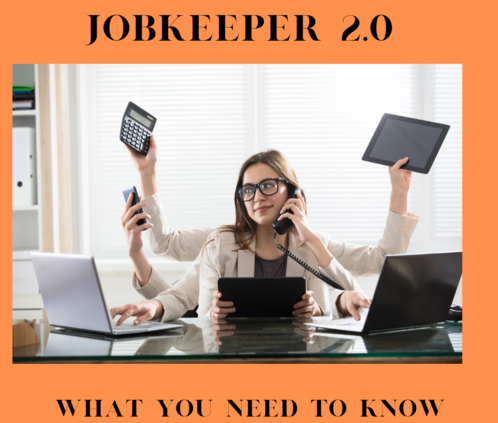This week is the crucial week for action for those on Jobkeeper 1.0 and those intending to continue to claim support via Jobkeeper 2.0. The long awaited alternative tests were released by the Commissioner of Taxation on 22 September giving us more clarity and some tools to assist our clients in determining their eligibility for Jobkeeper 2.0. Once again our mind is swimming as we seek to get the best support for our clients in this crazy time.
If you are one of the businesses who were not impacted sufficiently by COVID-19 to be eligible for Jobkeeper you must be very bored by these conversations by now. However, there are around 960,000 employers who have accessed Jobkeeper 1.0, and many are uncertain if they qualify for Jobkeeper 2.0. This make planning for the next 3 months very difficult if you are not sure of your eligibility. This week will hopefully bring the clarity you are waiting for as to your continued eligibility.
The announcement of the Jobkeeper extension was made on 21 July. Changes to the tests were quickly announced on 7 August as a result of the lockdown in Victoria. The alternative tests were released on 22 September demonstrating that the government is taking a more measured approach than the rush to bring support to businesses in April. Yet despite the delay in their release, the alternative tests are in line with the predictions of accountants trying to assess client eligibility.
Here is what you need to know:
The End of Jobkeeper 1.0
· If your business is currently receiving Jobkeeper 1.0, this finished on 27th September. You need to ensure that you have paid your staff at least the minimum of $1,500 for the fortnight 14th September – 27th September.
· Report your turnover for September using the regular monthly business declaration between 1 October – 14 October to receive the last of your payments for Jobkeeper 1.0 (being the payments for the two fortnights in September).
The start of Jobkeeper 2.0
· Assess if you are eligible to receive Jobkeeper 2.0. I will discuss how to assess this below.
· If you are eligible you need to assess which Tier of payment your staff fall into. This is determined by looking at the average number of hours the employee or business participant were actively engaged in the business in the four week period before either 1 March 2020 or 1 July 2020. If the average hours are more than 20 hours per week the employee or business participant receives a Tier 1 payment. If less than 20 hours, the employee receives a Tier 2 payment.
· Advise via Singe Touch Payroll which Tier of payment is applicable for each employee. If you don’t use Single Touch Payroll you will need to identify your employees when you make you submit your details on the Business Portal or MyGov.
· Make sure you pay the employee the minimum amount for each fortnight based on their Tier. The minimum amount is $1,200 per fortnight for Tier 1 and $750 per fortnight for Tier 2. You have until 31 October to get this minimum payment made for the first 2 fortnights of Jobkeeper 2.0, allowing you time to properly assess your eligibility.
· You will need to submit details of your businesses actual decline in turnover to the ATO between 1 – 31 October 2020.
· In November you will need to continue with the monthly business declaration, not only declaring your turnover but which Tier your employees were paid for over the course of the month.
· You will continue to be eligibly for Jobkeeper 2.0 until the next retest point at the end of December 2020.
Keep your employees informed
While there is no requirement to get new declarations from your employees for Jobkeeper 2.0, make sure you inform them of your eligibility, or not, so they can be aware of the circumstances.
Note, the eligibility tests for employees has not changed. If you had assessed the employee eligible for Jobkeeper 1.0, the employee will continue to be eligible for Jobkeeper 2.0. The start date of 1 July is the testing date for permanent employees and long term casuals and it is still the ”one in, all in” situation, meaning you cannot pick and choose which employees receive Jobkeeper.
The business eligibility test
When considering your eligibility for Jobkeeper 2.0, remember that this extension is really designed for the businesses who have been severely impacted by COVID-19. In many cases businesses have returned to normal trading (although maybe slightly reduced) in recent times. Jobkeeper 2.0 is largely designed to assist those in Victoria, and those in industries such as entertainment and tourism that simply cannot operate in a normal way at this stage. Of course, there will be a wider net of businesses that will pass the eligibility test because it is not exactly business as usual right now, but this test will be a lot more difficult to pass than the Jobkeeper 1.0 test.
When it came to testing for Jobkeeper 1.0 we had a few options. We could test on any month between March and August, or we could predict that the March- June quarter would show the required decline. The ATO accepted those predictions so long as there was a reasonable basis for them. We could choose between turnover on a Cash or on an Accrual basis. With many businesses trading in a very different capacity in April and May, it was relatively easy for an effected business to pass the test.
There are no predications in Jobkeeper 2.0. The test is based on actual figures and rather than looking at a month, it considers an entire quarter. We need to look at the actual GST turnover from July- September for our comparatives. The ATO prefer you to compare on the same basis as your Business Activity Statement (you either report on a cash or accrual basis) although they have said you can use the other basis this may be questioned by the ATO when your BAS comparisons don’t stack up.
The comparatives will be based on what your reported as your GST Turnover in your July- September 2020 BAS, and your July – September 2019 BAS. To be eligible you need to show the 30% decline in turnover this year compared to last year, unless your business has a turnover of more than $1 billion per annum, in which case you need to show a 50% decline. The decline in turnover test for charities and not for profits is still 15%.
For most businesses it should be very simple to compare and determine eligibility. If you qualify you will get Jobkeeper 2.0 from October – December. You do not need to retest again until the end of December when a further extension is available at a further reduced rate until 28 March 2021.
Do not by surprised if you have dropped out for Jobkeeper 2.0. If things go particularly bad in the October- December quarter the Government have left the door open for you to retest for the January- March quarter and jump back into the scheme. Fingers crossed that will not be necessary.
The Alternative Tests
Aware that circumstances may prevent the traditional test to be appropriate for some businesses, the ATO has issued alternative tests that may be used. These tests are very similar the initial alternative tests that were advised for Jobkeeper 1.0. Remember, these are designed for businesses that have unusual circumstances and to be eligible to use an alternative test you must satisfy a condition to use the test, as well as pass the alternative test itself.
Below is a table explaining the alternative tests. Note, if your business qualified for the ATO Bushfire’s 2019-2020 lodgement and payment deferrals, or received Drought Help concessions, you can exclude the months that these concessions or deferrals covered from the calculations, unless they are the only months that the business operated. If this is applicable to you, I suggest you read the legislation at this link for more details on how the bushfire or drought figures impacts your test.
https://www.legislation.gov.au/Details/F2020L01200


I know this seems extremely complicated and if you think one of these tests may apply to you, I strongly suggest you seek the advice of a professional.
It is going to be a busy month ahead with all these things to consider, along with Business Activity Statements to be lodged and our first of our lodgement deadlines coming up on 31 October 2020 (typically for those with overdue returns). Have patience with your accountant. They are doing their very best to get you through this challenging time.



